|
Natural History Museum 9
9-2013
|
This is a much better shot of Triceratops which is easy
to recognize because of it's head. Triceratops is Greek for
"three-horned face," but this dinosaur had only two real horns, the
third much shorter "horn" on its snout was made from a different material.
It's skull was one third the length of its entire body and can grow
to 7 feet long. It is believed that fully grown Triceratops were about
26 feet long, 10 feet in height, and weighed anywhere between 6 to 12
tons.
Triceratops had anywhere between 400 and 800 teeth
although only a small percentage of these were in use at any one time as
they were constantly replaced throughout its lifetime. Their diet
consisted of plants and grass's unlike some of his cousins that ate
meat. Triceratops lived about 65 million years ago and was one of the
last dinosaurs standing.
|
|
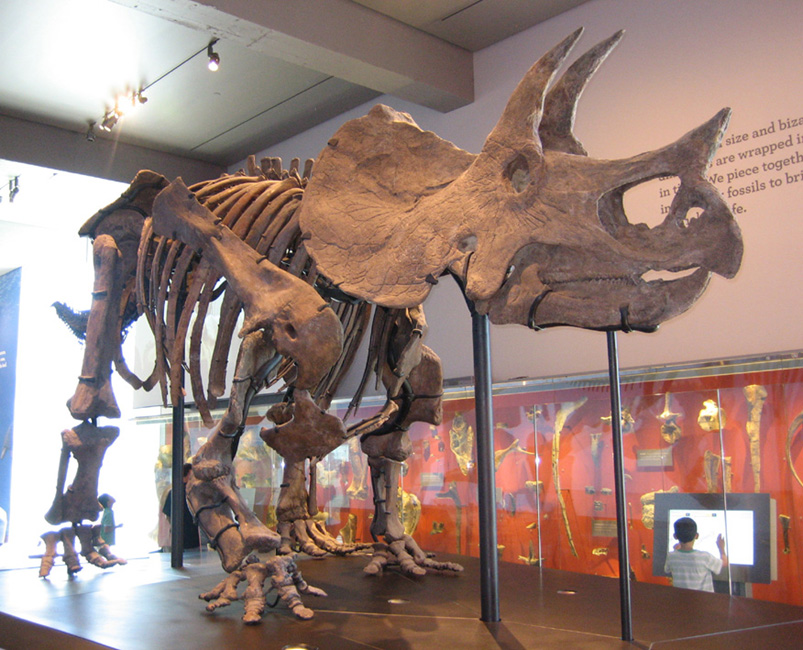 |
|
Mamenchisaurus (pronounced 'Ma-man-chee-sore-uss')
was a long necked, long-tailed,
plant eating dinosaur. Mamenchisaurus means 'Mamenchi (China) lizard)'
and had the longest neck of any known
dinosaur except the newly found Sauroposeidon. His neck alone is
about 46 feet long, overall length is 70 to 80 feet long and weighed
roughly 12 tons. It had 19 vertebrae in its neck, more than any other
known dinosaur had.
The long neck may have been used to poke into forests to
get foliage that was otherwise unavailable to smaller dinosaurs. Many
paleontologists believe that it used its massive neck to eat foliage on
the ground. They believe that Mamenchisaurus would have swung its neck
in a giant arc, eating everything it could eat. Then it would have taken
a step forward, and started the process over again. Mamenchisaurus lived
during the late Jurassic Period, from about 156 million to 145 million
years ago. He was a sauropod, whose intelligence (as measured by its
relative brain to body weight, or EQ) was among the lowest of the
dinosaurs.
|
|
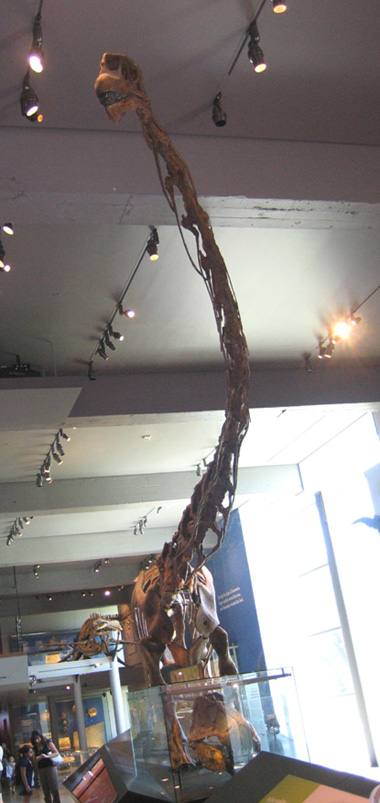 |
This is a close-up of Mamenchisaurus' lower half. The bones on this
dinosaur are impressively huge and look like tree trunks which makes
sense because of their massive weight.
|
|
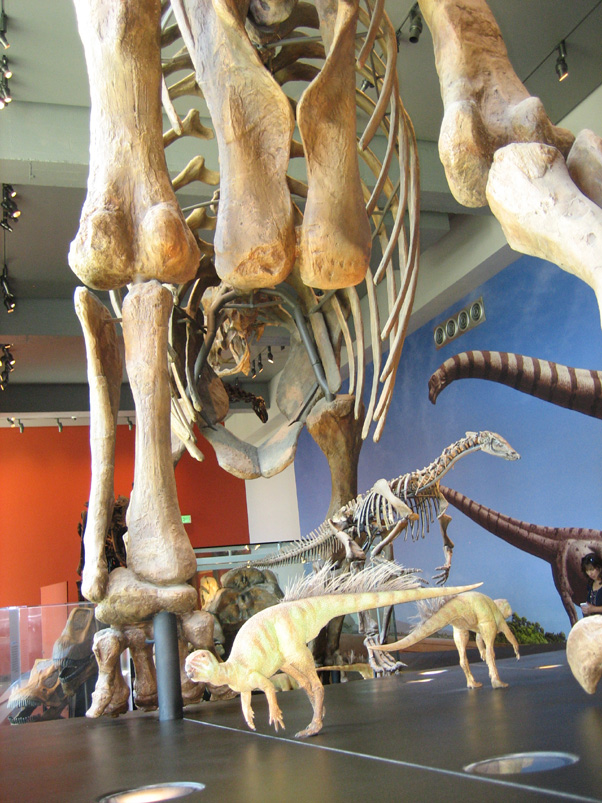 |
I could easily fit inside the ribcage and climb across the bones like a
jungle gym in a park. Impressive!
|
|
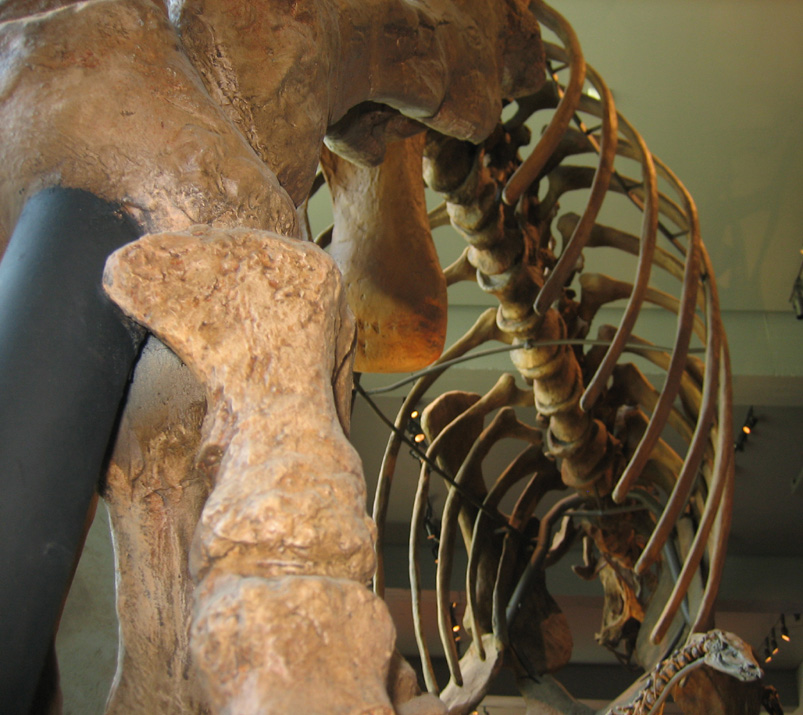 |
|
Tyrannosaurus Rex was the king of the dinosaurs and was
very big and very dangerous. The name Tyrannosaurus Rex means; Tyranno
meaning 'tyrant', sauros meaning 'lizard' and Rex meaning 'king'. Here you see a trio of them, all at
different ages. The smallest is 2 years old, 11 feet long and is the
youngest known T. Rex fossil in the world. To his right is a 20 feet
long, 13 year old weighing about 4,000 pounds. The oldest at 17 years
old, 34 feet long and weighed nearly 7,000 pounds. All three fossils
were found in the badlands of Montana.
|
|
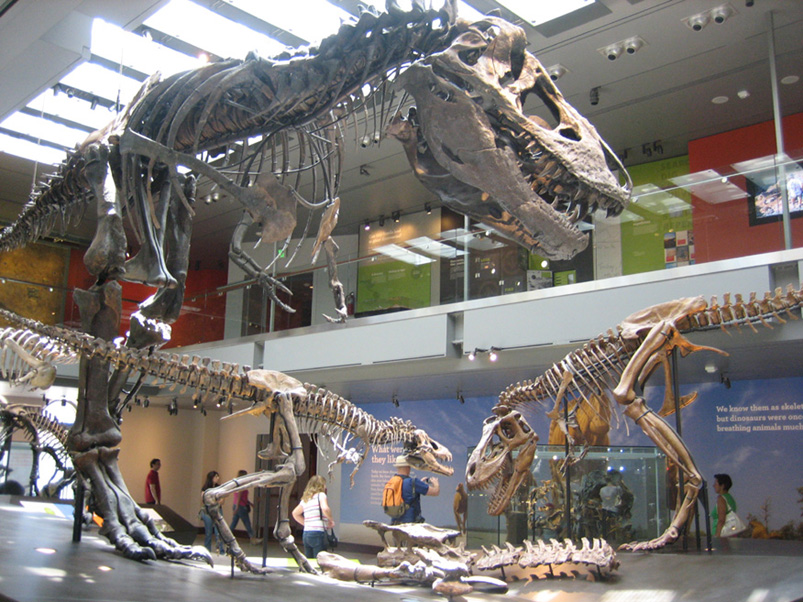 |
|
No one knows why T. Rex's arms were so short. Did they
use their small arms to push itself off the ground after restful naps,
or to clasp struggling prey close to its chest? Or is it possible that
this predator's arms were completely useless and would have disappeared
entirely (as happened with snakes) after another few million years of
evolution? No one knows but it looks to me they didn't do enough bench
press and did way to much stepper :-]
Based on the size and shape of its olfactory lobes
(nostrils), T. Rex seems to have had a very sensitive nose, which would
have helped it to hone in on living or dead and rotting prey. The
females were believed to be larger than the males and weighed more by a
few thousand pounds based on the size of existing fossils and the shapes
of their hips.
|
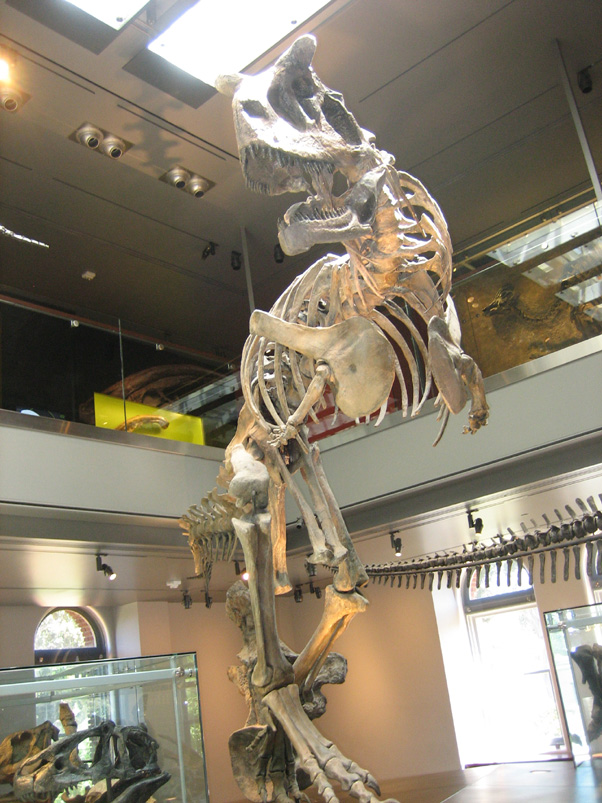
|
|
Tyrannosaurus Rex had an incredibly powerful bite and
enormous teeth with knifelike serrations.
Scientists determined that T. Rex chomped on its prey with anywhere from
1,500 to 3,000 pounds of force, comparable to a modern alligator. But
more recent studies put that figure in the 5,000 pound range. For
comparison the average adult human can bite with a force of about 175
pounds. A bite that powerful may have been capable of shearing off a
Triceratops' horns.
As you can see I was having fun with this picture.
|
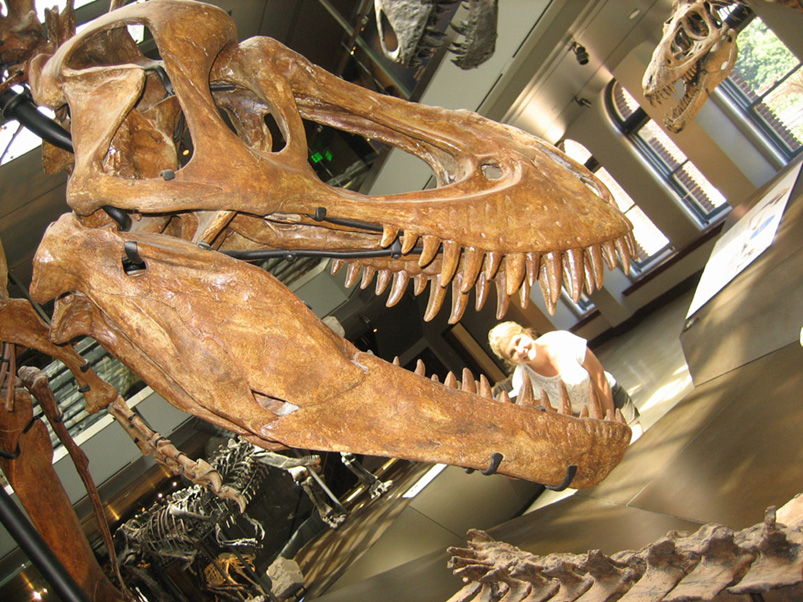
|
|
It's hard to tell a dinosaur's life span from its fossil
remains, but based on an analysis of existing specimens, experts
speculate that Tyrannosaurus Rex may have lived as long as 30 years. And
since this dinosaur was on top of the food chain, it was most likely
killed by old age, disease, or hunger rather than attacks by another
dinosaur. It's estimated that T. Rex could gain at mid spurt about 1,500
pounds in a year.
|
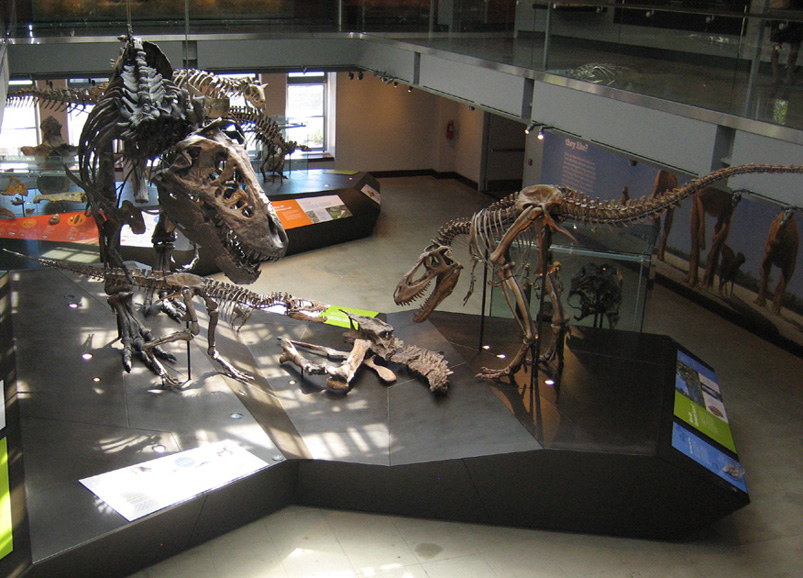
|
|
Camptosaurus was a plant eating dinosaur of the Late
Jurassic period where most were large. Camptosaurus was an exception, it
reached an adult weight of no more than 1,000 pounds. Camptosaurus means
'flexible lizard' and stood around five feet tall at the hips. Some paleontologists
compare Camptosaurus with a deer in today's forests. Camptosaurus
browsed on low vegetation and the chisel-like teeth on the sides of its jaws
were strong and well suited for crushing tough plants. Instead of front
teeth for nipping, the fronts of both jaws were covered with a beak.
Using its tail as a counterweight, Camptosaurus was
able to balance on its hind legs, leaving its arms for feeding and other
tasks, such as self defense. Fossilized tracks show evidence that Camptosaurus also walked on all fours at times.
|
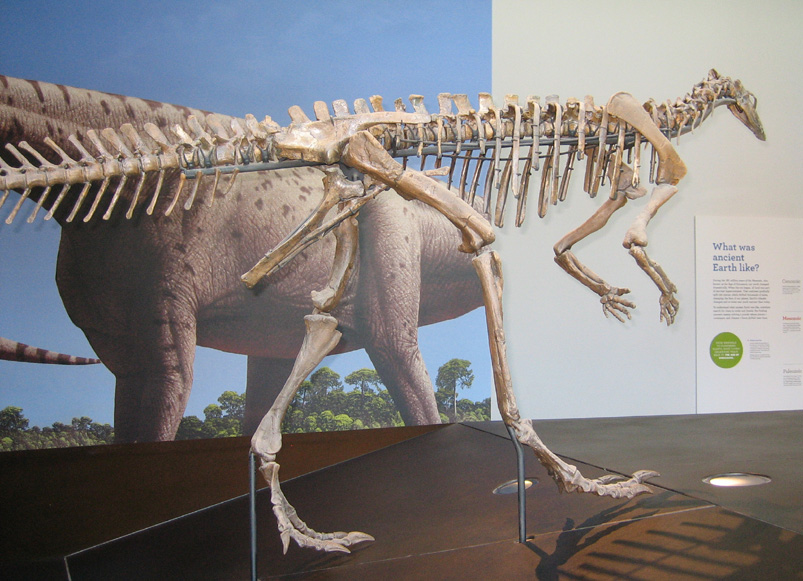
|
|
Stegosaurus is an armored dinosaur covered with 17 bony
plates that were embedded in its back which ran along its back and tail
in two rows, and the plates alternated in alignment. The largest of
these triangular plates was about 2.5 feet tall and just as long.
Stegosaurus also had spikes at the end of its flexible tail that could
be used as weapons. The name Stegosaurus means Roofed Lizard or Plated
Lizard.
Stegosaurus was 26-30 feet long long, 9 feet tall at the
hips and weighed about 7000 pounds. They were about the size
of a bus but had unusually small brains, only about the size of a
walnut. They were plant eaters but also ate rocks to help mash up the
tough vegetable matter in its enormous stomach, of which it would have
had to eat hundreds of pounds a day. This one was found in Utah and it's
around 150 million years old.
|
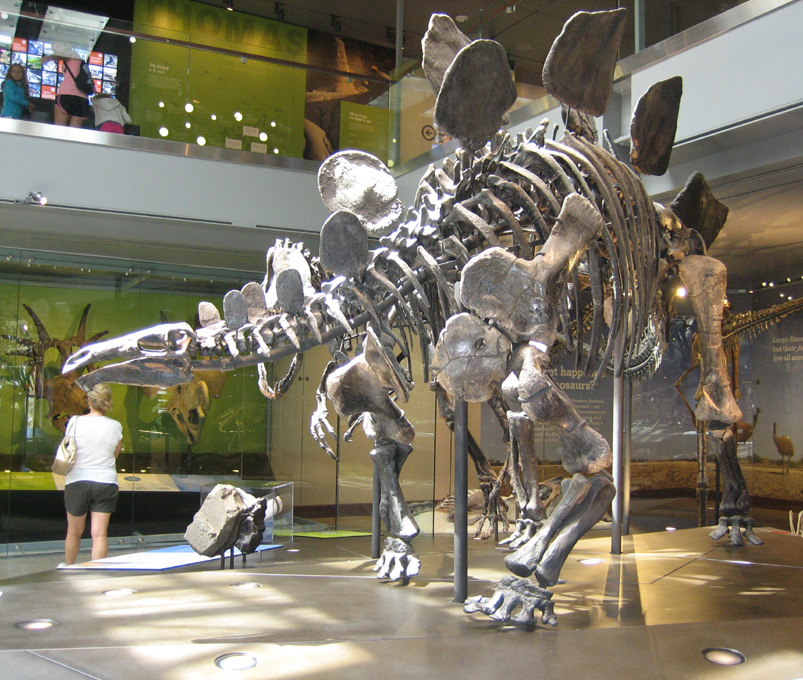 |
|
1
2
3
4
5
6
7
8
9
10
11
12 |
|